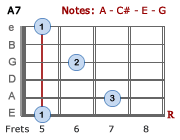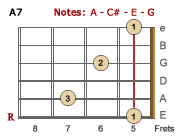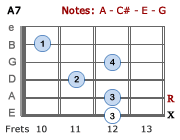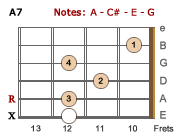A7 guitar chords
A - C# - E - GA7 - A seventh (1-3-5-b7)
Spelling: 1st(A), 3rd (C#), 5th(E), b7th(G)
Chart Legend
Numbered Circles: number inside circle indicates which finger to useX: Don't play string
White Numbered Circles: Optional Notes
X on string with optional note: if you omit the note, don't play string
Unmarked strings: Play open
Barre Line: One finger holds down multiple strings
R: Root Note
TAB: Numbers represent frets - not finger positions
Blank Strings: Do not Play
0: play string open
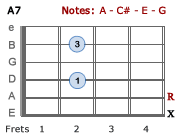
Written: x02020
Notes: x-A-E-G-C#-E
Form/chord shape: A7
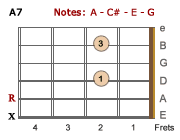
TAB e |-0-| B |-2-| G |-0-| D |-2-| A |-0-| E |---|
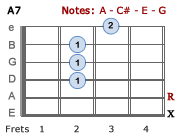
Written: x-0-2-2-2-3
Notes: x-A-E-A-C#-G
Form/chord shape: A
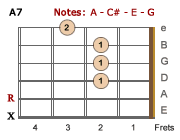
TAB e |-3-| B |-2-| G |-2-| D |-2-| A |-0-| E |---|
↓ A7 Guitar Chords
🎸 Why Don’t We Play the Low E String in the A7 Chord?
You might have heard the advice: “Don’t play the 6th string (low E) when strumming an A7 chord in first position.” But why?
📚 A Quick Look at the A7 ChordThe A7 chord contains four notes:
- A (root)
- C# (major 3rd)
- E (perfect 5th)
- G (minor 7th, also called the dominant 7th)
- The root (A) anchors the chord.
- The 5th (E) adds strength and stability.
- The 7th (G) gives the chord its bluesy, dominant flavor.
- The 3rd (C#) defines the major quality but is generally weaker in terms of harmonic pull.
🎵 First Position Voicings: With or Without the Low E?
There are two common ways to play A7 in open position:
1. Without the Low E (5-string version):
Notes: A - E - G - C# - E- Balance: Root-heavy with a nice mix — 1 root, 2 fifths, 1 third, 1 seventh
- Sound: Clear and balanced
- ✅ Recommended
2. With the Low E (6-string version):
Notes: E - A - E - G - C# - E- Balance: Now we have 3 fifths (E notes) and only 1 root.
- Sound: The added low E overpowers the root, making the chord sound muddy and less focused.
- ⚠️ Not ideal — especially when playing with others or in a recording.
🎧 Trust Your Ears
Strum both versions back to back. You’ll notice how the chord sounds tighter and more centered without that extra low E.
The low E isn’t a wrong note — it belongs to the chord — but its position in the bass shifts the balance too much toward the fifth, weakening the feel of A as the root.
🎯 General Tips for Building Chords That Sound Good
When voicing your own chords, especially 4-note or more extended shapes:
- Aim for a balanced mix of chord tones.
- Start with the root note in the bass whenever possible.
- If the root isn’t available, the 5th is a safe backup.
- The 7th (in 7th chords) adds tension and wants to resolve to the root — use it wisely.
- And most importantly: trust your ears. If a chord sounds off, analyze the voicing and adjust accordingly.
